Folks,
No updates for the next six weeks or so, I will be shipping out to sea for that time, and will be unable to update. I hope to get one more update done later tonight with my ship, the SSV Corwith Cramer.
Read more!
Sunday, October 12, 2008
Friday, October 3, 2008
HMS Shearwater
I meant to get this post published last night, however the VP debate and commentary thereafter unfortunately took my attention away from this post. This week's ship is a classic World War Two corvette/sloop of war (it may be classified as either depending on one's interpretation), the HMS Shearwater (L39)
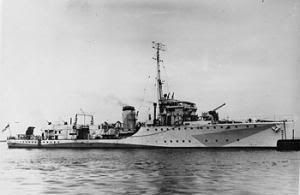
Stats from Colledge's Ships of the Royal Navy, which can also be found on the Wikipedia page for this ship:
Launched: 18 April, 1939
Commissioned: 7 September, 1939
Decommissioned: 21 April, 1947
Length: 234 ft
Beam: 26 ft 6 in
Draught: 6 ft 6 in
Displacement: 580 tons
Compliment: 55 enlisted, 5 officers
Speed: 20 kts
Power Plant: 2 X 3600 hp geared steam turbines
Armament: 1 QF 4 Mark V 4'/45 caliber gun mounted forward
4 .50 caliber Vickers machine guns
2 depth charge racks, stern mounted
The HMS Shearwater was the last of the Kingfisher class sloops/corvettes, a class which was designed in the mid 1930's as a limited ocean escort vessel for coastal and short ocean escorts. This and subsequent classes came into heavy use at the onset of World War II, where they were needed for convoy escorts across the Atlantic. Upon completion, the Shearwater was based out of various shipping ports along the southern coast of Britian to operate in concert with other corvettes and destroyers, usually multiple corvettes and a single destroyer as flotilla commander, to escort British shipping out into the Atlantic, providing protection from enemy aircraft and U-Boats. The Shearwater is most notable for being the corvette under the command of nautical themed author Nicholas Monsarrat, his first command, and thought to be the first patrol craft (sloop, corvette, patrol boat, or destoyer) under the command of a RNVR officer.
One item that the Shearwater brings up is her confusion in classification between sloop of war, and corvette. By this time, both classifications were being used to refer to small patrol craft; the aspect of using the rig of the ship to identify it became for the most part extinct with rise of the age of steam. However, British guidelines of the 1930's indicated that all small patrol craft not intended for fleet deployment would be classified as sloops. It wasn't until the explosion of shipbuilding in the Second World War that there became a distinction among these small patrol craft. The most commonly accepted difference is in size and propulsion, the sloops were generally smaller and single screwed, while corvettes were generally larger and carried twin screws. Thus, by this classification, the Shearwater would be a corvette, although such details are largely left to the history books in this day in age. But nonetheless an interesting topic of discussion.
Read more!

Stats from Colledge's Ships of the Royal Navy, which can also be found on the Wikipedia page for this ship:
Launched: 18 April, 1939
Commissioned: 7 September, 1939
Decommissioned: 21 April, 1947
Length: 234 ft
Beam: 26 ft 6 in
Draught: 6 ft 6 in
Displacement: 580 tons
Compliment: 55 enlisted, 5 officers
Speed: 20 kts
Power Plant: 2 X 3600 hp geared steam turbines
Armament: 1 QF 4 Mark V 4'/45 caliber gun mounted forward
4 .50 caliber Vickers machine guns
2 depth charge racks, stern mounted
The HMS Shearwater was the last of the Kingfisher class sloops/corvettes, a class which was designed in the mid 1930's as a limited ocean escort vessel for coastal and short ocean escorts. This and subsequent classes came into heavy use at the onset of World War II, where they were needed for convoy escorts across the Atlantic. Upon completion, the Shearwater was based out of various shipping ports along the southern coast of Britian to operate in concert with other corvettes and destroyers, usually multiple corvettes and a single destroyer as flotilla commander, to escort British shipping out into the Atlantic, providing protection from enemy aircraft and U-Boats. The Shearwater is most notable for being the corvette under the command of nautical themed author Nicholas Monsarrat, his first command, and thought to be the first patrol craft (sloop, corvette, patrol boat, or destoyer) under the command of a RNVR officer.
One item that the Shearwater brings up is her confusion in classification between sloop of war, and corvette. By this time, both classifications were being used to refer to small patrol craft; the aspect of using the rig of the ship to identify it became for the most part extinct with rise of the age of steam. However, British guidelines of the 1930's indicated that all small patrol craft not intended for fleet deployment would be classified as sloops. It wasn't until the explosion of shipbuilding in the Second World War that there became a distinction among these small patrol craft. The most commonly accepted difference is in size and propulsion, the sloops were generally smaller and single screwed, while corvettes were generally larger and carried twin screws. Thus, by this classification, the Shearwater would be a corvette, although such details are largely left to the history books in this day in age. But nonetheless an interesting topic of discussion.
Read more!
Wednesday, October 1, 2008
Review!
These past couple of weeks I have been delving into maritime literature, mostly nonfiction historical works, and I figured I would review some of the best of these works here, given that they all tie into historical ships that I may choose to feature at a later date. The first work here is a wonderful look into patrol craft life in the Atlantic during the Second World War. Three Corvettes, by Nicholas Monsarrat details Monserrat's service on three different Corvettes in the Atlantic. This week's ship, which I hope to have up tomorrow, is one of these corvettes, the HMS Shearwater (L39).
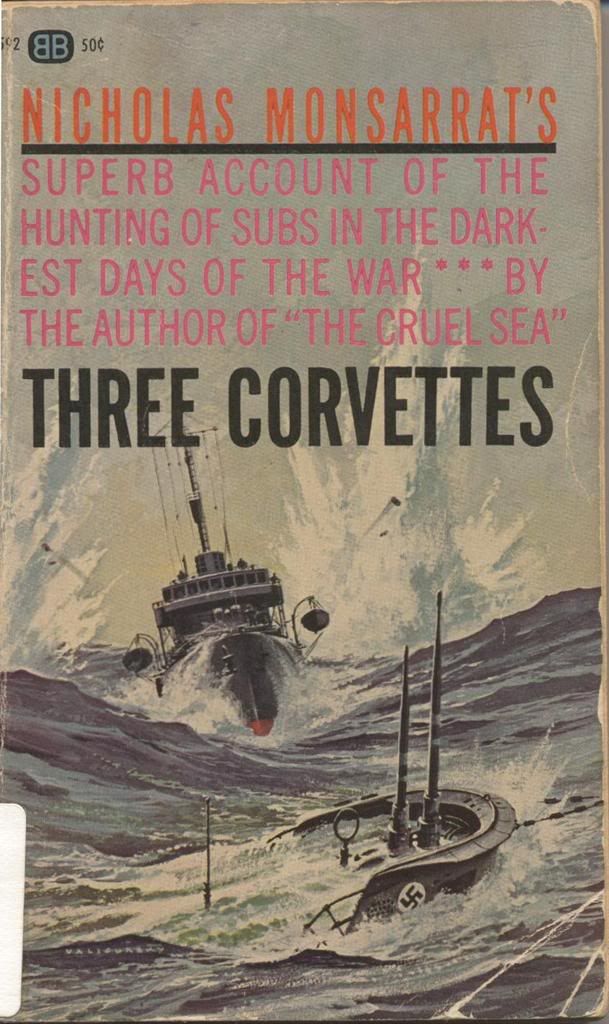
Three Corvettes is an autobiographical work written in the form of a log or journal during the time of Monserrat's service, from 1940 to 1943. It is uniquely written in a manner that avoids any censurship; thus Monserrat does not use actual names for people or vessels. Rather, for his companions he uses a single initial, and ship names are fictional, however they do relate to the actual ships he served on.
Monserrat entered the Royal Navy (RN) from the Royal Navy Volunteer Reserve (RNVR), a civilian component of the RN, his RNVR service was such that he was granted a commission as a junior lieutenant aboard an Atlantic escort Corvette as his first assignment. After performing well at that role he was promoted to the First Lieutenant of a second Corvette before moving to take command of his own ship for his third year in service.
Monserrat writes these three works in a unique observational writing style; as they are for the most part excerpts written during the course of his experiences they contain the flavor of shorter stories compiled into one big picture. Due to, I think, his unfamiliarity coming into the military world from civilian life, Monserrat provides the reader with a unique glimpse into the regimented military life, and conversely, the management of power by those who possess it. He writes of many observations that, to the professional naval officer might seem mundane, daily tasks, but to Monserrat and the reader both, they are new experiences, such as pecilular actions of the ordinary sailors, or the thrill of power whilst standing watch, having 750 tons of fighting men and machine answerable to your every command.
While this book can be hard to find because of it's age (published in 1953), and limited public reputation, it is nonetheless a wonderful read and insight into a little-known aspect of the Battle of the Atlantic in the Second World War.
Read more!

Three Corvettes is an autobiographical work written in the form of a log or journal during the time of Monserrat's service, from 1940 to 1943. It is uniquely written in a manner that avoids any censurship; thus Monserrat does not use actual names for people or vessels. Rather, for his companions he uses a single initial, and ship names are fictional, however they do relate to the actual ships he served on.
Monserrat entered the Royal Navy (RN) from the Royal Navy Volunteer Reserve (RNVR), a civilian component of the RN, his RNVR service was such that he was granted a commission as a junior lieutenant aboard an Atlantic escort Corvette as his first assignment. After performing well at that role he was promoted to the First Lieutenant of a second Corvette before moving to take command of his own ship for his third year in service.
Monserrat writes these three works in a unique observational writing style; as they are for the most part excerpts written during the course of his experiences they contain the flavor of shorter stories compiled into one big picture. Due to, I think, his unfamiliarity coming into the military world from civilian life, Monserrat provides the reader with a unique glimpse into the regimented military life, and conversely, the management of power by those who possess it. He writes of many observations that, to the professional naval officer might seem mundane, daily tasks, but to Monserrat and the reader both, they are new experiences, such as pecilular actions of the ordinary sailors, or the thrill of power whilst standing watch, having 750 tons of fighting men and machine answerable to your every command.
While this book can be hard to find because of it's age (published in 1953), and limited public reputation, it is nonetheless a wonderful read and insight into a little-known aspect of the Battle of the Atlantic in the Second World War.
Read more!
Wednesday, September 24, 2008
CSS Shenandoah
This week's ship is arguably the second most famous Confederate raider after the CSS Alabama, and the only Confederate ship to circumnavigate the world: the CSS Shenandoah.
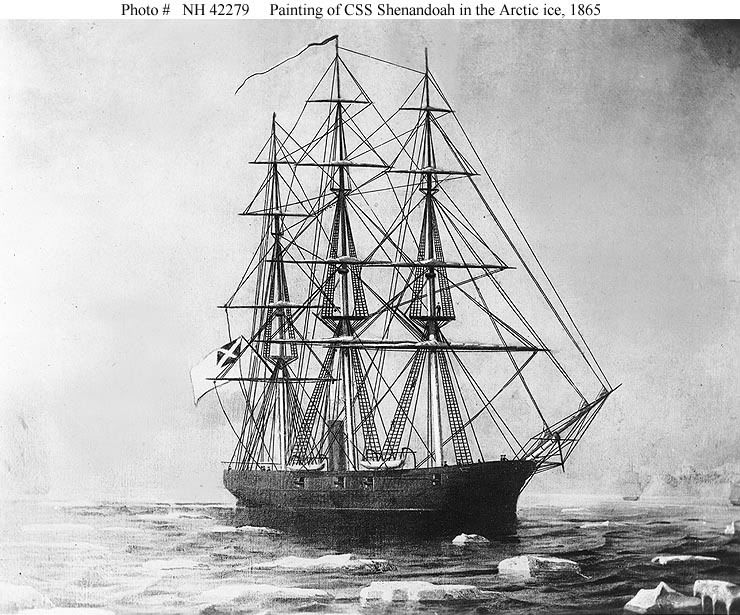
Stats from the US Navy:
Launched: August 1963 (as the HMS Sea King)
Commissioned: 19 October, 1964
Decommissioned: 6 November, 1865
Length: 230 ft
Beam: 32 ft
Draught: 20 ft 6 inches
Displacement: 1160 tons
Compliment: 109
Speed: 9 kts under steam
Rig: Ship rigged
Power Plant: steam engine and single shaft
Armament: 4 8" smoothbore cannon
2 32 pound rifled cannon
2 12 pound cannon
Prior to her historic voyage as the CSS Shenandoah, the ship she would become was known as the HMS Sea King and was designed as a British Troop Transport. On 8 October, 1864, the Sea King set sail in theory for British India, however she secretly rendezvoused with a Confederate steamer in the Madeiras Islands, off the coast of Africa, where she received her armaments and a portion of her crew, and was transformed from transport to cruiser-raider. Her commanding officer, Lieutenant James I. Waddell, oversaw her conversion, and after assembling a scant half crew from volunteers from the original crew of the former Sea King and from the Confederate steamer, commissioned the ship the CSS Shenandoah.
The plan drawn up by the Confederate Navy Department was for the Shenandoah to travel around the Cape of Good Hope and through the Indian Ocean, and raid the formerly safe waters of the Pacific Ocean, concentrating on American whaling ships, and merchant ships in trade with Africa. By early 1865, she had crossed the South Atlantic and Indian oceans, taking several prizes, and burning the majority of them. Arriving in the Pacific, the Shenandoah docked in Melbourne, Australia, to take on additional crew and supplies. Waddell then headed north across the Pacific, wreaking havoc on the American whaling fleet, especially in the region along the Bearing Strait just south of the Arctic circle. After capturing (and burning the majority of) 21 prizes, on his run south along the coast of Latin America, Waddell recieved news on 2 August from a British ship about the American Civil War's termination some four months prior. At that date, the crew of the Shenandoah removed all traces of her being a Confederate warship, including dismounting all guns and painting the ship to look like a merchant vessel. She continued around Cape Horn, and on November 6th, 1865, Waddell and crew entered Liverpool, Great Britian, and surrendered to the British, thus ending the career of the only Confederate warship to circumnavigate the globe.
Read more!

Stats from the US Navy:
Launched: August 1963 (as the HMS Sea King)
Commissioned: 19 October, 1964
Decommissioned: 6 November, 1865
Length: 230 ft
Beam: 32 ft
Draught: 20 ft 6 inches
Displacement: 1160 tons
Compliment: 109
Speed: 9 kts under steam
Rig: Ship rigged
Power Plant: steam engine and single shaft
Armament: 4 8" smoothbore cannon
2 32 pound rifled cannon
2 12 pound cannon
Prior to her historic voyage as the CSS Shenandoah, the ship she would become was known as the HMS Sea King and was designed as a British Troop Transport. On 8 October, 1864, the Sea King set sail in theory for British India, however she secretly rendezvoused with a Confederate steamer in the Madeiras Islands, off the coast of Africa, where she received her armaments and a portion of her crew, and was transformed from transport to cruiser-raider. Her commanding officer, Lieutenant James I. Waddell, oversaw her conversion, and after assembling a scant half crew from volunteers from the original crew of the former Sea King and from the Confederate steamer, commissioned the ship the CSS Shenandoah.
The plan drawn up by the Confederate Navy Department was for the Shenandoah to travel around the Cape of Good Hope and through the Indian Ocean, and raid the formerly safe waters of the Pacific Ocean, concentrating on American whaling ships, and merchant ships in trade with Africa. By early 1865, she had crossed the South Atlantic and Indian oceans, taking several prizes, and burning the majority of them. Arriving in the Pacific, the Shenandoah docked in Melbourne, Australia, to take on additional crew and supplies. Waddell then headed north across the Pacific, wreaking havoc on the American whaling fleet, especially in the region along the Bearing Strait just south of the Arctic circle. After capturing (and burning the majority of) 21 prizes, on his run south along the coast of Latin America, Waddell recieved news on 2 August from a British ship about the American Civil War's termination some four months prior. At that date, the crew of the Shenandoah removed all traces of her being a Confederate warship, including dismounting all guns and painting the ship to look like a merchant vessel. She continued around Cape Horn, and on November 6th, 1865, Waddell and crew entered Liverpool, Great Britian, and surrendered to the British, thus ending the career of the only Confederate warship to circumnavigate the globe.
Read more!
Friday, September 19, 2008
The Mayflower II
This week's ship I'm going to do a little differently; I had a chance to visit the actual ship, so I'm going to take you on a photo tour of the vessel. But first, a little background information:
The Mayflower II was conceived of and built in 1955 - 1957, as a gift from Britain to America as a symbol of wartime cooperation between the two nations. It was built in Devonshire, England, in as traditional method as possible, including hemp cordage and hand drawn iron nails. She was sailed from England to Britain in the spring of 1957, on a slightly more south but otherwise accurate route that the original Mayflower would have sailed. The ship is still seaworthy and occasionally makes voyages for important functions.
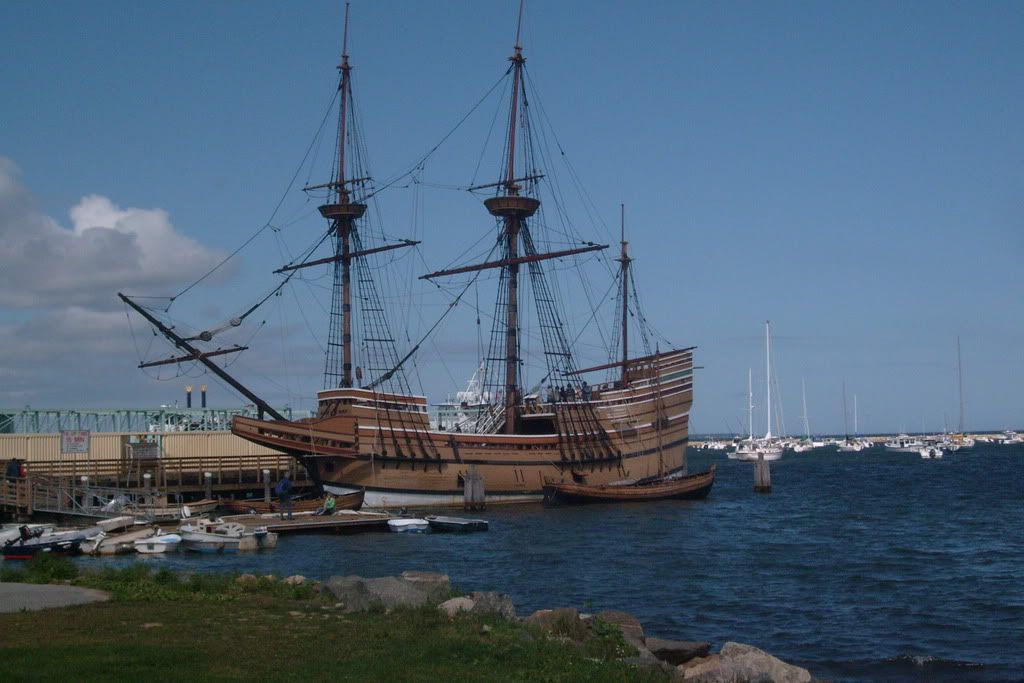
Read more!
The Mayflower II was conceived of and built in 1955 - 1957, as a gift from Britain to America as a symbol of wartime cooperation between the two nations. It was built in Devonshire, England, in as traditional method as possible, including hemp cordage and hand drawn iron nails. She was sailed from England to Britain in the spring of 1957, on a slightly more south but otherwise accurate route that the original Mayflower would have sailed. The ship is still seaworthy and occasionally makes voyages for important functions.

The Mayflower II at dock
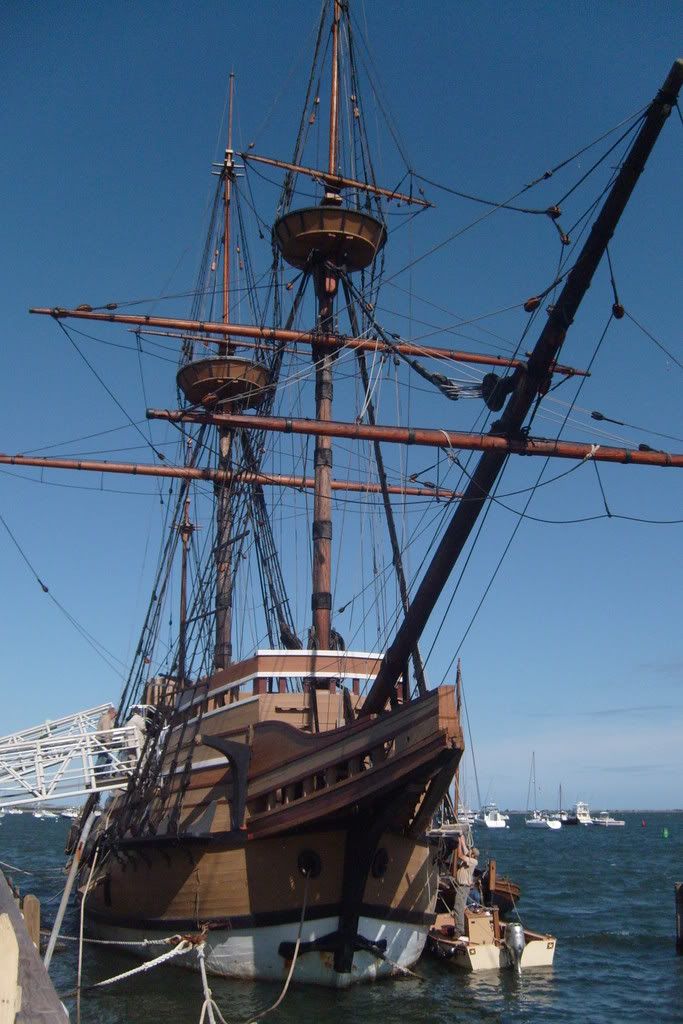
Bow view. Notice the length of the bowsprit and the spritsail yard, which are both indicative of a ship of this period, as over the course of the next century, the spritsail would be done away with and the bowsprit shortened considerably.
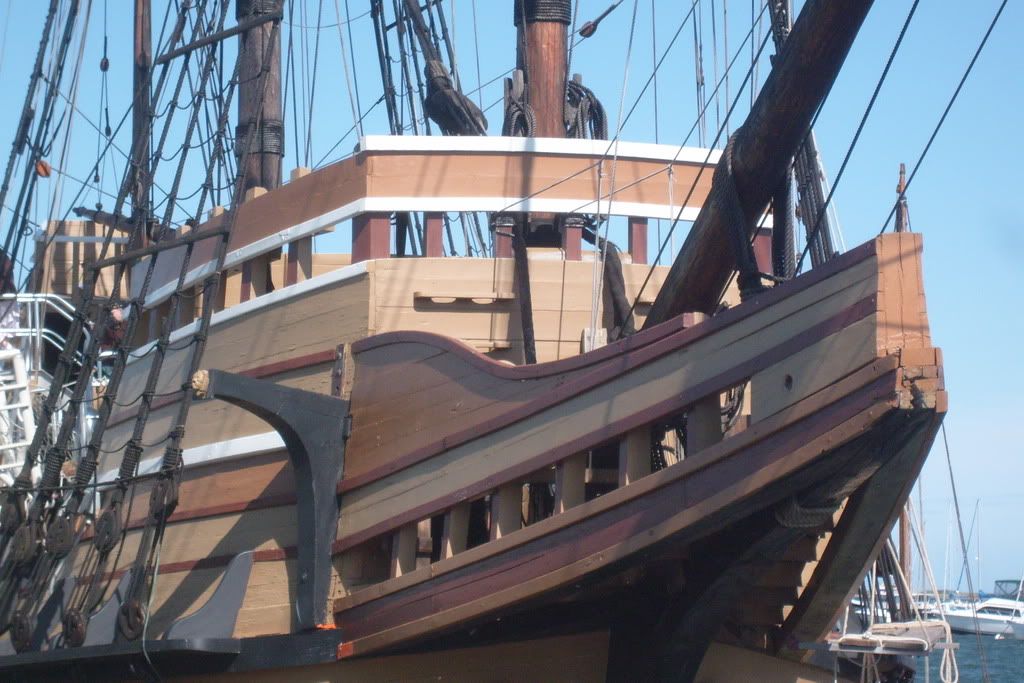 The Fo'c's'le. Notice the mounting of the fore chains to the hull below the fo'c's'le deck, and the short distance between that and the bowsprit.
The Fo'c's'le. Notice the mounting of the fore chains to the hull below the fo'c's'le deck, and the short distance between that and the bowsprit.
 The main deck, or spar deck, looking forward
The main deck, or spar deck, looking forward
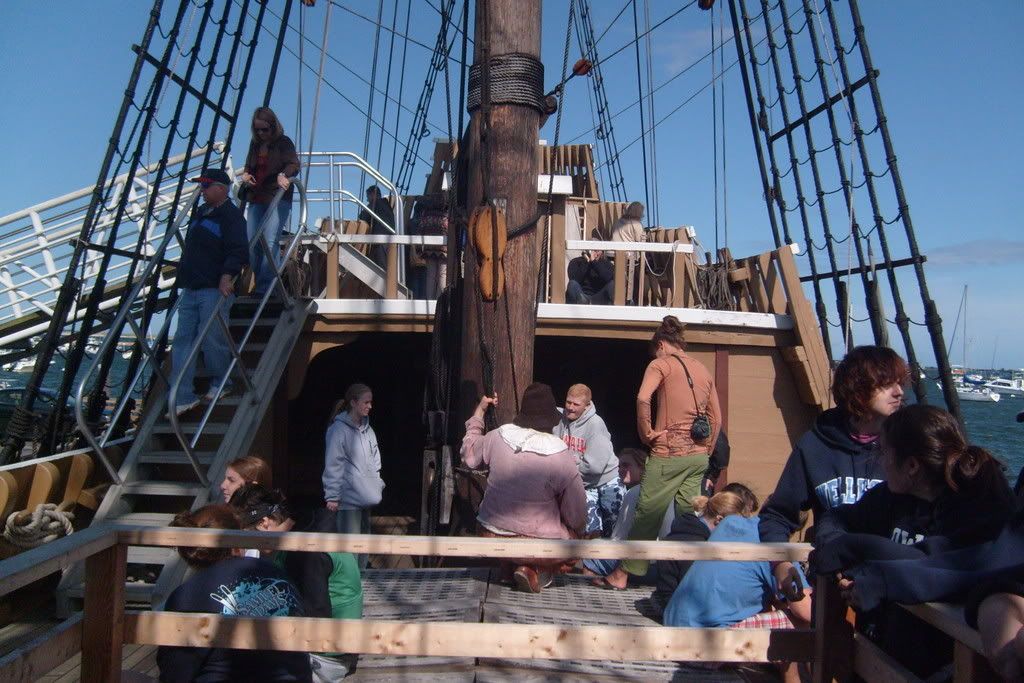 The main deck, or spar deck, looking aft. The helm lies in the alcove center aft on the deck, with the great cabin behind.
The main deck, or spar deck, looking aft. The helm lies in the alcove center aft on the deck, with the great cabin behind.
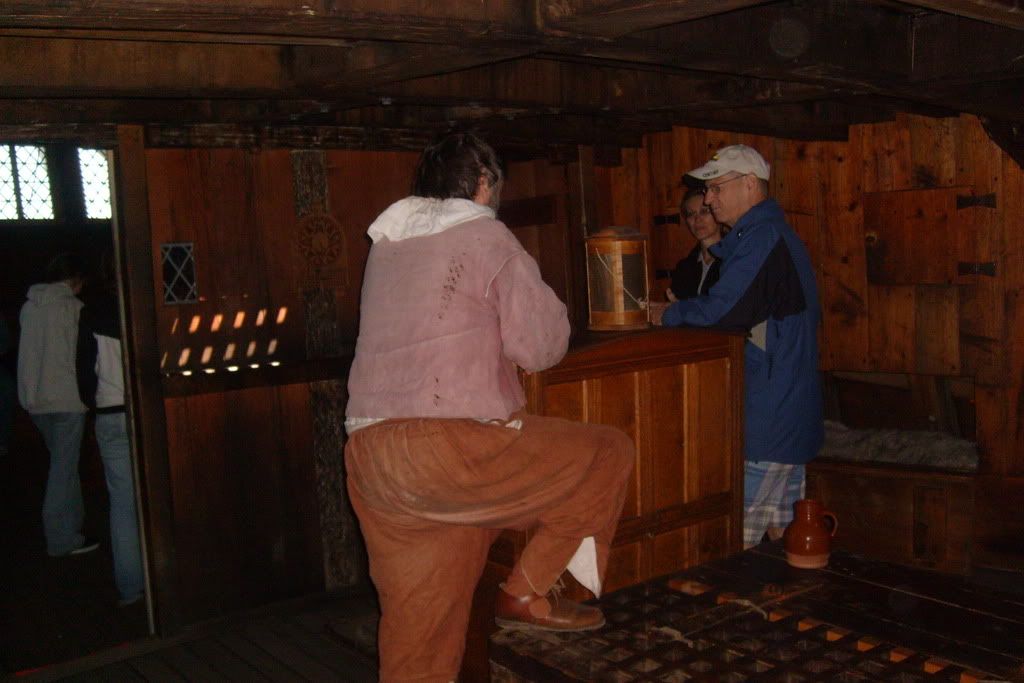 The helm alcove. The grating in the foreground leads belowdeck, and the whipstaff, the intermediate helm design between a tiller and a wheel, lies directly behind the interpretor.
The helm alcove. The grating in the foreground leads belowdeck, and the whipstaff, the intermediate helm design between a tiller and a wheel, lies directly behind the interpretor.
 Belowdecks forward: The cable tier
Belowdecks forward: The cable tier
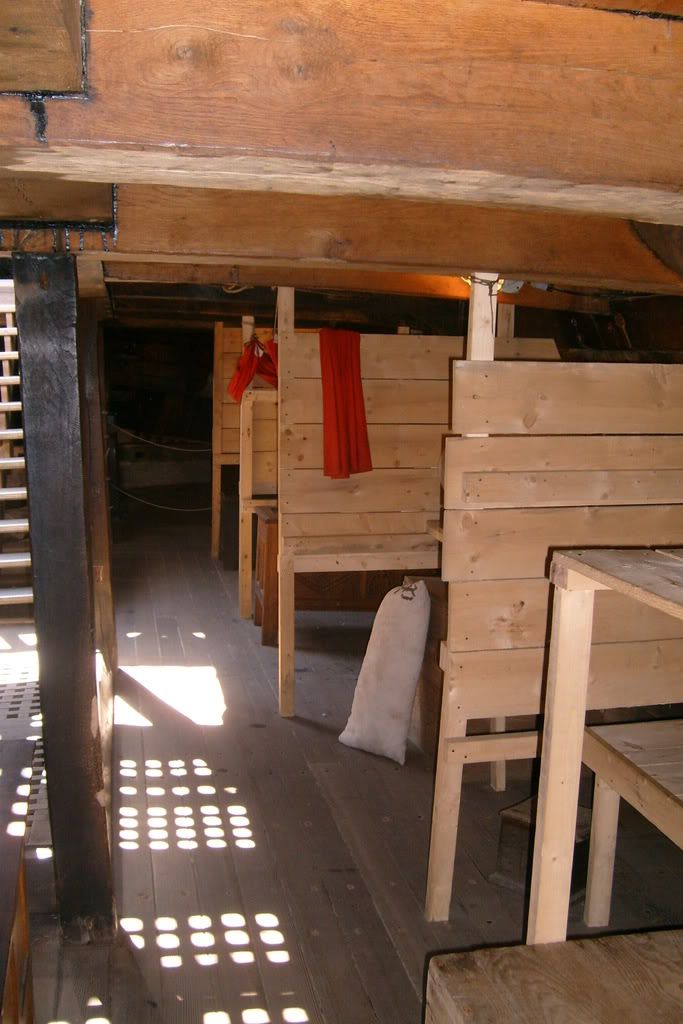 Belowdecks midships: passenger stalls.
Belowdecks midships: passenger stalls.
 Belowdecks aft. Notice the simple joint between the whipstaff and the rudder, as well as the relieving tackle which would be manned in the advent of heavy weather to augment the helmsman above. While it is unknown if the Mayflower was armed, were she, she would have most likely carried 9 pounders such as the one above mounted as a stern chaser.
Belowdecks aft. Notice the simple joint between the whipstaff and the rudder, as well as the relieving tackle which would be manned in the advent of heavy weather to augment the helmsman above. While it is unknown if the Mayflower was armed, were she, she would have most likely carried 9 pounders such as the one above mounted as a stern chaser.

Bow view. Notice the length of the bowsprit and the spritsail yard, which are both indicative of a ship of this period, as over the course of the next century, the spritsail would be done away with and the bowsprit shortened considerably.
 The Fo'c's'le. Notice the mounting of the fore chains to the hull below the fo'c's'le deck, and the short distance between that and the bowsprit.
The Fo'c's'le. Notice the mounting of the fore chains to the hull below the fo'c's'le deck, and the short distance between that and the bowsprit. The main deck, or spar deck, looking forward
The main deck, or spar deck, looking forward The main deck, or spar deck, looking aft. The helm lies in the alcove center aft on the deck, with the great cabin behind.
The main deck, or spar deck, looking aft. The helm lies in the alcove center aft on the deck, with the great cabin behind. The helm alcove. The grating in the foreground leads belowdeck, and the whipstaff, the intermediate helm design between a tiller and a wheel, lies directly behind the interpretor.
The helm alcove. The grating in the foreground leads belowdeck, and the whipstaff, the intermediate helm design between a tiller and a wheel, lies directly behind the interpretor. Belowdecks forward: The cable tier
Belowdecks forward: The cable tier Belowdecks midships: passenger stalls.
Belowdecks midships: passenger stalls. Belowdecks aft. Notice the simple joint between the whipstaff and the rudder, as well as the relieving tackle which would be manned in the advent of heavy weather to augment the helmsman above. While it is unknown if the Mayflower was armed, were she, she would have most likely carried 9 pounders such as the one above mounted as a stern chaser.
Belowdecks aft. Notice the simple joint between the whipstaff and the rudder, as well as the relieving tackle which would be manned in the advent of heavy weather to augment the helmsman above. While it is unknown if the Mayflower was armed, were she, she would have most likely carried 9 pounders such as the one above mounted as a stern chaser.Read more!
Monday, September 8, 2008
NOAAS Delaware II
I apologize for the lack of a post this past week folks; I have been having pretty serious computer and network issues; it resulted in me having to re-install my operating system which was a pain. But I'm back and up and running with this week's ship: The NOAAS Delaware II, who I was fortunate to be able to visit this week.
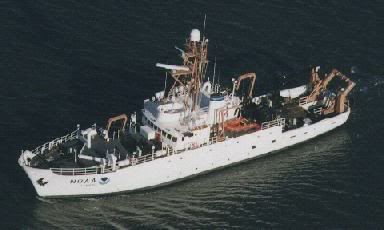
Stats from the NOAA site for the Deleware II:
Launched: December 1967
Commissioned: 12 March, 1975
Length: 155 ft
Beam: 30 ft
Draught: 16.6 ft
Displacement: 897 tons
Compliment: 10 crew, 14 scientists max
Speed: 10 kts
Power Plant: 1200 HP GM geared diesel
The NOAAS Deleware II is a Fisheries Research Vessel for the National Marine Fisheries Service (NMFS), a component of the National Oceanic and Atmospheric Administration (NOAA), homeported in Woods Hole, MA. Commissioned in 1975, the Deleware II underwent servicing and upgrades in 1996 which allowed her the capability to operate well into the 21st century. She is currently slated to be decomissioned and replaced in the next 5 years.
The Deleware II is utilized to provide research on a variety of fisheries along the North East coast of the United States, specializing in Georges Bank, off the coast of Cape Cod. She posesses a stern trawl with a variety of nets for research catching, as well as an acoustic profiler and Acoustic Doppler Current Profiler (ADCP) in order to provide scientists with information regarding both fish concentrations and information about currents. She is usually deployed for 2 to 3 week cruises, during which her range allows her to conduct research on fisheries from the coast of main down to the northern coast of North Carolina.
Read more!

Stats from the NOAA site for the Deleware II:
Launched: December 1967
Commissioned: 12 March, 1975
Length: 155 ft
Beam: 30 ft
Draught: 16.6 ft
Displacement: 897 tons
Compliment: 10 crew, 14 scientists max
Speed: 10 kts
Power Plant: 1200 HP GM geared diesel
The NOAAS Deleware II is a Fisheries Research Vessel for the National Marine Fisheries Service (NMFS), a component of the National Oceanic and Atmospheric Administration (NOAA), homeported in Woods Hole, MA. Commissioned in 1975, the Deleware II underwent servicing and upgrades in 1996 which allowed her the capability to operate well into the 21st century. She is currently slated to be decomissioned and replaced in the next 5 years.
The Deleware II is utilized to provide research on a variety of fisheries along the North East coast of the United States, specializing in Georges Bank, off the coast of Cape Cod. She posesses a stern trawl with a variety of nets for research catching, as well as an acoustic profiler and Acoustic Doppler Current Profiler (ADCP) in order to provide scientists with information regarding both fish concentrations and information about currents. She is usually deployed for 2 to 3 week cruises, during which her range allows her to conduct research on fisheries from the coast of main down to the northern coast of North Carolina.
Read more!
Sunday, August 24, 2008
Charles W. Morgan
This week's ship is the only surviving example of an 1800th century wooden whaling ship, the Charles W. Morgan.

Stats from the ship's webpage:
Launched: 1861
Retired: 1921 as a museum ship
Length: 113 ft
Beam: 27 ft 6 in
Draught: 17 ft 6 in
Displacement: 314 tons
Compliment: variable
Rig: Double topsail bark
Read more!

Stats from the ship's webpage:
Launched: 1861
Retired: 1921 as a museum ship
Length: 113 ft
Beam: 27 ft 6 in
Draught: 17 ft 6 in
Displacement: 314 tons
Compliment: variable
Rig: Double topsail bark
Read more!
Monday, August 18, 2008
PFS Polarstern
This week's ship is the fascinating German Icebreaker, the PFS Polarstern
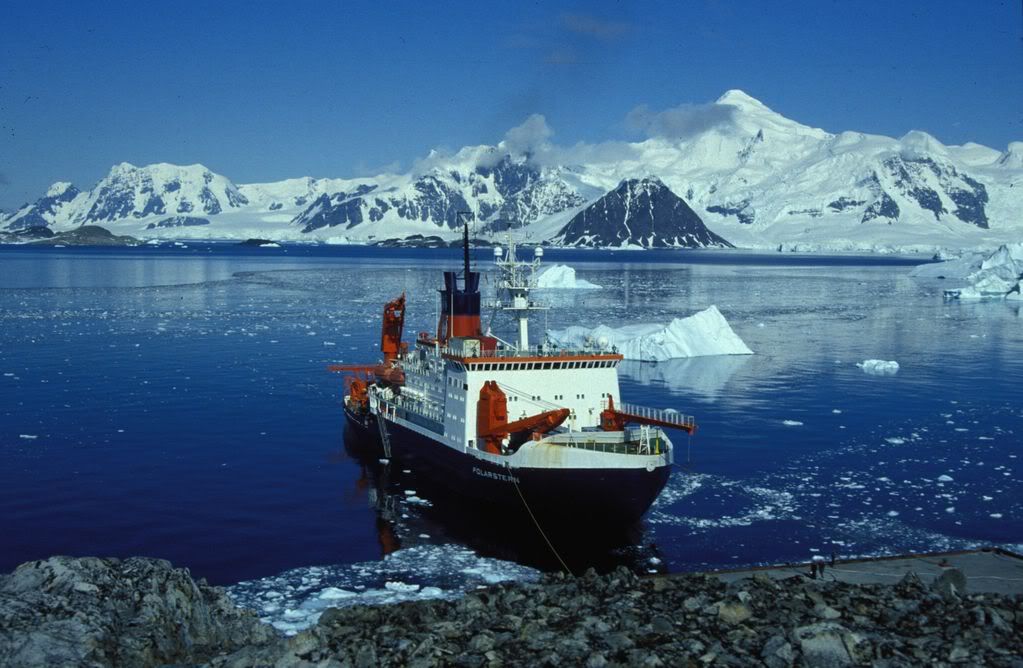
Stats from the ship's official website:
Launched: 1 December, 1982
Commissioned: 9 December, 1982
Length: 387 ft
Beam: 82 ft
Draught: 36 ft 9 in
Displacement: 17,300 tons
Compliment: maximum of 44 scientists and crew
Speed: 16 kts
Power Plant: 20,000 hp on 4 main diesel engines
The PFS Polarstern (en: Pole Star) is an icebreaker oceanographic research vessel managed by the Alfred Wegener Institute for Polar and Marine Research in Germany. Constructed in 1982, she possesses a double bottom, and the capacity to break through 5 feet of ice under way, and deeper ice by ramming. The design had the requirement to function both as a research and supply vessel in polar regions of the Northern and Southern hemisphere. "This resulted in the necessity for an icebreaker, on the one hand and a sturdy ocean going vessel capable of traversing long distances on the other. RV Polarstern was completely overhauled between 1998 and 2001 (midlife conversion) in order to meet the most advanced technical standards and prolong the total service life by another 10 to 15 years" (official website).
Read more!

Stats from the ship's official website:
Launched: 1 December, 1982
Commissioned: 9 December, 1982
Length: 387 ft
Beam: 82 ft
Draught: 36 ft 9 in
Displacement: 17,300 tons
Compliment: maximum of 44 scientists and crew
Speed: 16 kts
Power Plant: 20,000 hp on 4 main diesel engines
The PFS Polarstern (en: Pole Star) is an icebreaker oceanographic research vessel managed by the Alfred Wegener Institute for Polar and Marine Research in Germany. Constructed in 1982, she possesses a double bottom, and the capacity to break through 5 feet of ice under way, and deeper ice by ramming. The design had the requirement to function both as a research and supply vessel in polar regions of the Northern and Southern hemisphere. "This resulted in the necessity for an icebreaker, on the one hand and a sturdy ocean going vessel capable of traversing long distances on the other. RV Polarstern was completely overhauled between 1998 and 2001 (midlife conversion) in order to meet the most advanced technical standards and prolong the total service life by another 10 to 15 years" (official website).
Read more!
Thursday, July 31, 2008
PCU New Mexico (SSN-779)
This week's ship honors the state I've been working in for the past couple of months. The second vessel to be named after the state of New Mexico, the PCU New Mexico is a Virginia class attack submarine under construction at Newport News, with a launch date of mid 2010.
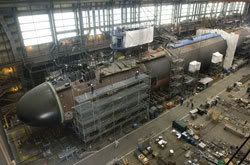
Design stats from the ship's website:
Launched: Scheduled for 13 December, 2008
Commissioned: Scheduled for 2009
Decommissioned:
Life expectancy: 33 years
Length: 377 ft
Beam: 34 ft
Submergence Depth: in excess of 800 ft
Displacement: 7835 tons submerged
Compliment: 134 total, 118 when deployed
Speed: > 25 kts
Power Plant: 40,000 hp ducted propeller, powered by 1 SG9 pressurized water reactor
Armament: 4 forward launch torpedo tubes, 12 vertical launch missile tubes
The PCU (Pre Commissioned Unit) New Mexico is the second ship in the US Navy to be named after the state, the first being the Battleship (BB-40). The New Mexico is one of a new fleet of Virginia class attack submarines, a cheaper alternative to the Seawolf class, and a replacement for the aging Los Angeles class of attack submarines. The New Mexico is a multi-mission platform, designed not only for attack, but also for ELINT, and as a staging platform for small unit (SEAL) operations.
Read more!

Design stats from the ship's website:
Launched: Scheduled for 13 December, 2008
Commissioned: Scheduled for 2009
Decommissioned:
Life expectancy: 33 years
Length: 377 ft
Beam: 34 ft
Submergence Depth: in excess of 800 ft
Displacement: 7835 tons submerged
Compliment: 134 total, 118 when deployed
Speed: > 25 kts
Power Plant: 40,000 hp ducted propeller, powered by 1 SG9 pressurized water reactor
Armament: 4 forward launch torpedo tubes, 12 vertical launch missile tubes
The PCU (Pre Commissioned Unit) New Mexico is the second ship in the US Navy to be named after the state, the first being the Battleship (BB-40). The New Mexico is one of a new fleet of Virginia class attack submarines, a cheaper alternative to the Seawolf class, and a replacement for the aging Los Angeles class of attack submarines. The New Mexico is a multi-mission platform, designed not only for attack, but also for ELINT, and as a staging platform for small unit (SEAL) operations.
Read more!
Tuesday, July 8, 2008
Falls of Clyde
This week's ship is one of unique status, the only sail-rigged oil tanker in existance, the Falls of Clyde
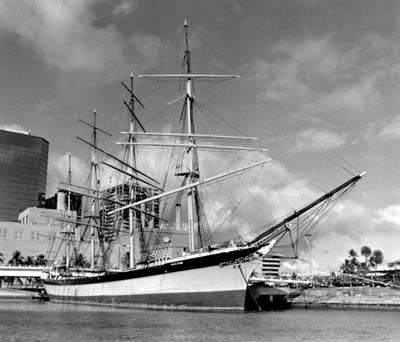
Stats from the National Park Service:
Launched: 1878
Retired: 1922 (as a hulk)
Length: 266.1 ft
Beam: 40.0 ft
Draught: 21.0 ft
Displacement: 1707 tons
Compliment: variable
Rig: Launched as a 4 masted ship rig, converted to bark in 1899
Built in Glasgow, Scotland, in1878 as the launching of a steel hulled windjammer fleet for the Glasgow Falls Line, the Falls of Clyde takes her name after the Scottish waterfall, as were the GFL's subsiquent ships. The Falls of Clyde made her career for the first twenty years of her life transporting bulk cargo that was still economical for sailing ships to transport: wheat from American Pacific Coast, nitrates from Chile, as well as cement, jute, and iron. In 1898 she was sold, and homeported in San Francisco, where through legislation she acquired a US registry, allowing her to participate in the now domestic Hawaiian sugar trade (Hawaii beciming a US colony in 1898). From then until 1907, she participated in the Hawaiian trade, transporting general cargo and passengers from the American Pacific Coast to Hawaii, and returning laden with sugar.
In 1907, she was again sold to the Associated Oil Co. of California, for use in the Hawaiian trade. She was reconfigured with pumps and ten large tanks in her hold, and an open space on her top deck for barrels, and entered the oil trade, carrying approximately 19,000 barrels of oil per trip. She continued to make between 5 and 7 voyages to Hawaii a year until 1920, when she was again sold, and made two voyages carrying oil between the United States and Denmark. She made one final voyage under yet another owner, to Buenos Aires, before being laid up, and sold as a gasoline and oil storage hulk for 37 years in Ketchikan, Alaska.
In 1959, she was no longer used as a fuel hulk, and several times was nearly wrecked before she could be purchased for restoration as a museum ship. She was remasted and restored, and by 1970 was open to the public in much her original condition as a sailing oil tanker. Recently, however, funds have been lacking for her upkeep, and the Falls of Clyde stands the danger of sinking at dockside unless she receives substantial contributions.
Read more!

Stats from the National Park Service:
Launched: 1878
Retired: 1922 (as a hulk)
Length: 266.1 ft
Beam: 40.0 ft
Draught: 21.0 ft
Displacement: 1707 tons
Compliment: variable
Rig: Launched as a 4 masted ship rig, converted to bark in 1899
Built in Glasgow, Scotland, in1878 as the launching of a steel hulled windjammer fleet for the Glasgow Falls Line, the Falls of Clyde takes her name after the Scottish waterfall, as were the GFL's subsiquent ships. The Falls of Clyde made her career for the first twenty years of her life transporting bulk cargo that was still economical for sailing ships to transport: wheat from American Pacific Coast, nitrates from Chile, as well as cement, jute, and iron. In 1898 she was sold, and homeported in San Francisco, where through legislation she acquired a US registry, allowing her to participate in the now domestic Hawaiian sugar trade (Hawaii beciming a US colony in 1898). From then until 1907, she participated in the Hawaiian trade, transporting general cargo and passengers from the American Pacific Coast to Hawaii, and returning laden with sugar.
In 1907, she was again sold to the Associated Oil Co. of California, for use in the Hawaiian trade. She was reconfigured with pumps and ten large tanks in her hold, and an open space on her top deck for barrels, and entered the oil trade, carrying approximately 19,000 barrels of oil per trip. She continued to make between 5 and 7 voyages to Hawaii a year until 1920, when she was again sold, and made two voyages carrying oil between the United States and Denmark. She made one final voyage under yet another owner, to Buenos Aires, before being laid up, and sold as a gasoline and oil storage hulk for 37 years in Ketchikan, Alaska.
In 1959, she was no longer used as a fuel hulk, and several times was nearly wrecked before she could be purchased for restoration as a museum ship. She was remasted and restored, and by 1970 was open to the public in much her original condition as a sailing oil tanker. Recently, however, funds have been lacking for her upkeep, and the Falls of Clyde stands the danger of sinking at dockside unless she receives substantial contributions.
Read more!
Tuesday, June 17, 2008
MV Golden Nori
And now, for a more modern vessel, I give you the M/V Golden Nori:

Stats from Merchant Ships International:
Launched: March, 1997
Flagged: 05 December, 2000
Length: 383 ft, 10"
Beam: 65 ft, 7"
Draught: 28 ft, 9"
Displacement: 11,676 metric tonnes
Compliment: 28
Speed: 13 kts
The Golden Nori is a Japanese chemical and oil tanker built in 1997. She is registered under the Panamanian flag, and is licensed to carry Group I through IV oils, as well as non-petroleum oils. The Golden Nori is most famous for her 28 October 2007 hijacking by a group of pirates off of the coast of Somalia. Responding to the hijacking, a US Navy Destroyer sank the pirates craft, and shadowed them until they attempted to come into port on 12 December, and forced the pirates to relent and release the crew. The vessel is still in service.
Read more!

Stats from Merchant Ships International:
Launched: March, 1997
Flagged: 05 December, 2000
Length: 383 ft, 10"
Beam: 65 ft, 7"
Draught: 28 ft, 9"
Displacement: 11,676 metric tonnes
Compliment: 28
Speed: 13 kts
The Golden Nori is a Japanese chemical and oil tanker built in 1997. She is registered under the Panamanian flag, and is licensed to carry Group I through IV oils, as well as non-petroleum oils. The Golden Nori is most famous for her 28 October 2007 hijacking by a group of pirates off of the coast of Somalia. Responding to the hijacking, a US Navy Destroyer sank the pirates craft, and shadowed them until they attempted to come into port on 12 December, and forced the pirates to relent and release the crew. The vessel is still in service.
Read more!
Thursday, June 5, 2008
Friends,
Just to let you know, for the next couple of months I may not be updating regularly each week, I don't know what kind of access my job will give me to the internet. I shall try to update as frequently as possible, though.
Read more!
Just to let you know, for the next couple of months I may not be updating regularly each week, I don't know what kind of access my job will give me to the internet. I shall try to update as frequently as possible, though.
Read more!
Sunday, June 1, 2008
The Huáscar
This week's ship is one of very few pre-dreadnought ironclad ships still afloat, the Historic Replica Huáscar.

Stats from the official Chilean Navy website:
Hull number: 321
Contracted: 12 August, 1864
Launched: 7 October, 1865
Commissioned: December, 1865
Decommissioned: 1897
Length: 195 ft
Beam:
Draught: 15 ft
Displacement: 1180 L/t
Compliment: Unknown
Speed: 11 kts
Rig: Brigantine
Power Plant: 300 hp steam engine
Armament: 2 300 lb (10") cannon, turreted, forward
2 40 lb cannon
1 12 lb cannon
1 .44" Gatling gun
The Huáscar was ordered in 1864 in Britain by Peru, to provide the Peruvian fleet with a modern warship for use in their ongoing war with Spain at the time. Constructed along "Ericsson" design plans as an armoured semi-monitor, by the time the Huáscar was completed and made the journey around Cape Horn, the Spanish-Peruvian war had already concluded. She became the brightest ship in the Peruvian navy over the next decade, and became heavily involved in 1877 in the Peruvian Civil War, where she was seized by rebels in port, and operated for a month under a rebel crew, briefly engaging the English ships Amethyst and Sha before the rebels surrendered to the Peruvian government.
Two years later, she took part in the War of the Pacific, between Peru and neighboring Chile. The Huáscar sank the Chilean corvette Esmeralda before being captured at the battle of Angamos after a substantial portion of her crew, including her commanding officer Adm. Miguel Grau, died. She fought the remainder of the war under Chilean command, including being present at the Battle of Arica. In 1887, she was refit with new boilers, a steam engine to turn the turret, a larger stack, and repair work done to her double bottom and deck. Undergoing further repairs during the 1891 Chilean Civil War, she nonetheless took part on the side of the parliamentarians. In 1897, following a coal boiler explosion, she was decommissioned.
In 1934, the Huáscar was reinstated as a Museum Ship in the Talcahuano Naval Docks, where the tradition began that she would fly the ensign of the Commandant of the Chilean Second Naval Zone. Beginning in 1951, a complete refit of the ship was undertaken, restoring her to her 1878 condition and establishing the ship as a shrine to both the Chilean and Peruvian Navies. In 1971 and 1972, she was drydocked in order to repair her aging hull; at the same time her machinery was rebuilt according to original plans. She remains a museum ship, and open to the public as a Naval Monument
Read more!

Stats from the official Chilean Navy website:
Hull number: 321
Contracted: 12 August, 1864
Launched: 7 October, 1865
Commissioned: December, 1865
Decommissioned: 1897
Length: 195 ft
Beam:
Draught: 15 ft
Displacement: 1180 L/t
Compliment: Unknown
Speed: 11 kts
Rig: Brigantine
Power Plant: 300 hp steam engine
Armament: 2 300 lb (10") cannon, turreted, forward
2 40 lb cannon
1 12 lb cannon
1 .44" Gatling gun
The Huáscar was ordered in 1864 in Britain by Peru, to provide the Peruvian fleet with a modern warship for use in their ongoing war with Spain at the time. Constructed along "Ericsson" design plans as an armoured semi-monitor, by the time the Huáscar was completed and made the journey around Cape Horn, the Spanish-Peruvian war had already concluded. She became the brightest ship in the Peruvian navy over the next decade, and became heavily involved in 1877 in the Peruvian Civil War, where she was seized by rebels in port, and operated for a month under a rebel crew, briefly engaging the English ships Amethyst and Sha before the rebels surrendered to the Peruvian government.
Two years later, she took part in the War of the Pacific, between Peru and neighboring Chile. The Huáscar sank the Chilean corvette Esmeralda before being captured at the battle of Angamos after a substantial portion of her crew, including her commanding officer Adm. Miguel Grau, died. She fought the remainder of the war under Chilean command, including being present at the Battle of Arica. In 1887, she was refit with new boilers, a steam engine to turn the turret, a larger stack, and repair work done to her double bottom and deck. Undergoing further repairs during the 1891 Chilean Civil War, she nonetheless took part on the side of the parliamentarians. In 1897, following a coal boiler explosion, she was decommissioned.
In 1934, the Huáscar was reinstated as a Museum Ship in the Talcahuano Naval Docks, where the tradition began that she would fly the ensign of the Commandant of the Chilean Second Naval Zone. Beginning in 1951, a complete refit of the ship was undertaken, restoring her to her 1878 condition and establishing the ship as a shrine to both the Chilean and Peruvian Navies. In 1971 and 1972, she was drydocked in order to repair her aging hull; at the same time her machinery was rebuilt according to original plans. She remains a museum ship, and open to the public as a Naval Monument
Read more!
Tuesday, May 20, 2008
USS North Carolina
I figured I'd start this off with one my my most favorite ships, the first Museum Ship that I ever set foot on, and the ship that since grade school got me interested in maritime history: the USS North Carolina.
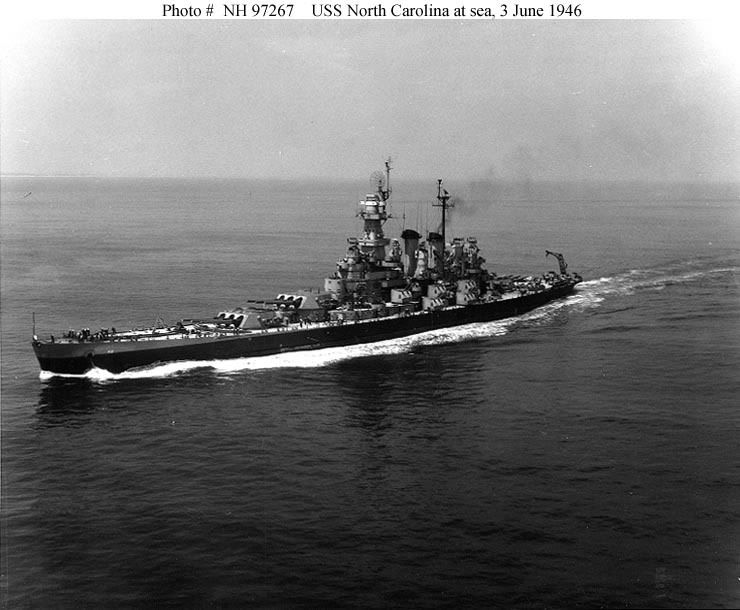
Stats from the official museum website here:
The USS North Carolina was the first of a two ship class of battleships, the North Carolina class, with sister ship the USS Washington (BB- 56) put into commission just over one month after the Carolina. She was the first battleship to be commissioned in the post Washington Naval Treaty period, and as such was a media spectacle throughout her fitting out and trials, earning her the nickname "Showboat". She was homeported on the East Coast during the Pearl Harbor attacks, and was transferred to the Pacific in June, 1942, where she would spend the remainder of the war.
Her primary duty during the war was screening the Attack Carriers from aircraft, and surface threats, as well as providing fire support to island landing campaigns when she was in a position to do so. On 15 September, 1942, while screening the carrier Hornet (CV - 8), the North Carolina "took a torpedo portside, 20 feet below her waterline, and 5 of her men were killed. But skillful damage control by her crew and the excellence of her construction prevented disaster; a 5.5 degree list was righted in as many minutes, and she maintained her station in a formation at 25 knots." (US Navy) This trial by fire demonstrated the resiliance of the modern battleship classes, as well as solidified their role as support screening vessels for aircraft carriers. After returning to Pearl Harbor for repairs, the North Carolina continued her role screening carriers across the Pacific until mid-spring 1943, when she returned to Pearl Harbor for a month of refitting and upgrades, specifically to her radar and fire control systems. Participating in the assaults of countless Pacific islands, including the Marshall Islands, New Guinea, Iwo Jima, and Okinawa. She concluded her Pacific career with the shelling of industrial plants in Tokyo.
Returning to Boston in October, 1945, the North Carolina served as a training vessel for midshipmen before being decommissioned and placed in reserve on June 27, 1947. In 1958, the notice of her impending scrapping generated a public outpouring of support in North Carolina to get the ship docked in the state as a museum ship, and by late 1961, she was purchased and moved in-state, to her final position on the Cape Fear River in Wilmington where in April 1962 she was dedicated as a statewide memorial to the North Carolina soldiers, sailors and Marines who fought and died in the Second World War.
The museum ship is very easily accessible, and tours cover a large portion of the ship, making it a must-see for the naval history buff visiting North Carolina.
Read more!

Stats from the official museum website here:
| Hull Number: | BB 55 |
| Keel Laid: | October 27, 1937 |
| Launched: | June 13, 1940 |
| Commissioned: | April 9, 1941 |
| Decommissioned: | June 27, 1947 |
| Length: | 728 feet 5/8 inches long |
| Extreme Beam: | 108 feet 3 7/8 inches wide |
| Mean Draught: | 31 feet 7 inches normal, 35 feet 6 inches maximum |
| Displacement: | 36,600 tons standard, 44,800 tons full load |
| Complement: | 2,339 (144 officers and 2,195 enlisted) |
| Speed: | 28 knots |
| Armament: | 9 16-inch/45 caliber guns 20 5-inch/38 caliber guns 60 40mm/56 caliber guns 48 20mm/70 caliber guns |
| |
Her primary duty during the war was screening the Attack Carriers from aircraft, and surface threats, as well as providing fire support to island landing campaigns when she was in a position to do so. On 15 September, 1942, while screening the carrier Hornet (CV - 8), the North Carolina "took a torpedo portside, 20 feet below her waterline, and 5 of her men were killed. But skillful damage control by her crew and the excellence of her construction prevented disaster; a 5.5 degree list was righted in as many minutes, and she maintained her station in a formation at 25 knots." (US Navy) This trial by fire demonstrated the resiliance of the modern battleship classes, as well as solidified their role as support screening vessels for aircraft carriers. After returning to Pearl Harbor for repairs, the North Carolina continued her role screening carriers across the Pacific until mid-spring 1943, when she returned to Pearl Harbor for a month of refitting and upgrades, specifically to her radar and fire control systems. Participating in the assaults of countless Pacific islands, including the Marshall Islands, New Guinea, Iwo Jima, and Okinawa. She concluded her Pacific career with the shelling of industrial plants in Tokyo.
Returning to Boston in October, 1945, the North Carolina served as a training vessel for midshipmen before being decommissioned and placed in reserve on June 27, 1947. In 1958, the notice of her impending scrapping generated a public outpouring of support in North Carolina to get the ship docked in the state as a museum ship, and by late 1961, she was purchased and moved in-state, to her final position on the Cape Fear River in Wilmington where in April 1962 she was dedicated as a statewide memorial to the North Carolina soldiers, sailors and Marines who fought and died in the Second World War.
The museum ship is very easily accessible, and tours cover a large portion of the ship, making it a must-see for the naval history buff visiting North Carolina.
Read more!
Subscribe to:
Posts (Atom)